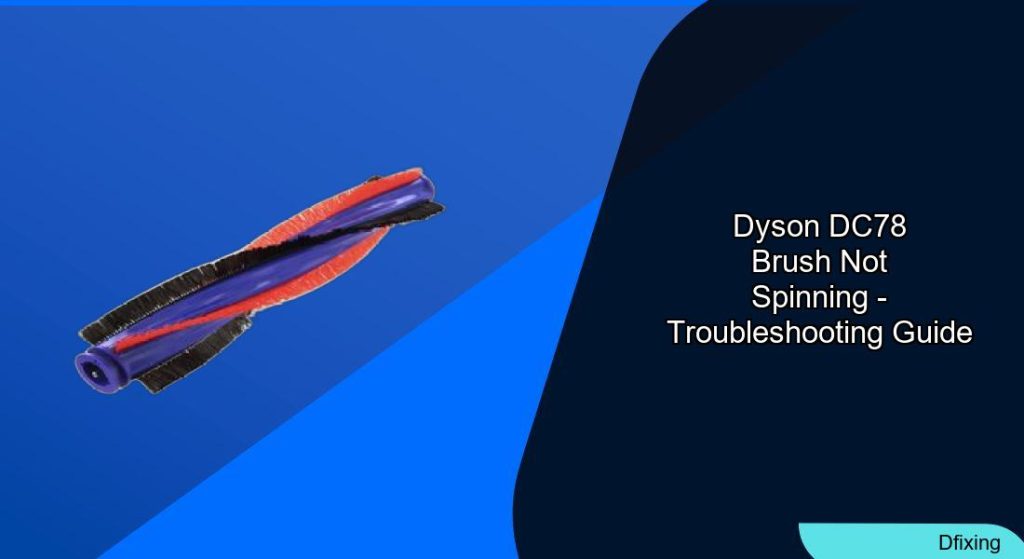A non-spinning brush bar on your Dyson DC78 can turn routine cleaning into a frustrating task. Poor suction, debris buildup, and unusual noises often signal a problem with the brush roll, belt, or motor. Fortunately, most issues can be resolved with basic tools and a methodical approach. This guide walks you through troubleshooting steps, repairs, and maintenance to restore your vacuum’s performance.
Affiliate disclosure: As an Amazon associate, We'll earn a commission for every successful order through our affiliate links in the article. However, you won’t be charged anything for this.
The root causes of a stalled brush bar range from simple blockages to mechanical wear. Hair and debris entanglement, stretched or broken belts, and motor failures are common culprits. By systematically addressing each possibility—from clearing jams to replacing worn parts—you can diagnose and fix the issue without professional help. Regular maintenance also plays a key role in preventing future problems, ensuring your Dyson DC78 operates efficiently for years.
Common Causes of a Non-Spinning Brush Bar

The Dyson DC78’s brush bar relies on a belt-driven mechanism connected to the motor. When the brush stops spinning, the problem often lies in:
– Blockages: Hair, threads, or debris wrapped around the brush roll or motor shaft.
– Worn or Broken Belts: A stretched or snapped belt fails to transfer power from the motor to the brush.
– Brush Roll Damage: Worn bearings or internal mechanical failures in the brush assembly.
– Electrical Issues: Faulty motor connections or damaged circuitry.
Identifying the exact cause requires inspecting accessible components and testing the motor’s functionality.
Step-by-Step Troubleshooting Guide
Clearing Blockages
- Turn off and unplug the vacuum to ensure safety.
- Remove the front plate using a screwdriver or coin to access the brush bar.
- Inspect for hair or debris around the brush roll. Use scissors or a seam ripper to cut and remove obstructions.
- Check the motor shaft for hair buildup between the triangle piece and the shaft. Clear any debris carefully.
Inspecting and Replacing the Belt
- Access the belt after removing the front plate.
- Check for wear: A cracked, stretched, or broken belt needs replacement.
- Replace the belt by sliding it off the motor shaft and brush roll. Install a new belt, ensuring it aligns with both components.
Testing the Brush Roll
If the belt is intact but the brush still won’t spin:
1. Manually rotate the black knobs on the brush head. Resistance indicates a jam or bearing issue.
2. Disassemble the brush roll: Remove Torx screws (T8 size) and pull off the knobs to clean internal mechanisms.
3. Lubricate moving parts with white lithium grease to reduce friction.
Replacing the Brush Roll
When cleaning and belt replacement fail to resolve the issue, a new brush roll may be necessary.
Replacement Steps
- Unplug the vacuum and remove the front plate.
- Detach the belt from the motor and brush roll.
- Pry out the old brush roll using a flat-head screwdriver.
- Install the new brush roll, ensuring proper alignment.
- Reattach the belt and front plate.
- Test the vacuum to confirm the brush spins freely.
Post-Replacement Checks
- Belt tension: The belt should have slight give when pressed.
- Alignment: Ensure the brush roll sits securely and the belt engages the motor.
- Motor function: If the brush still doesn’t spin, test the motor with a multimeter for continuity.
Advanced Repairs: Fused Parts and Motor Issues

Repairing Fused Plastic Components
Hair buildup can generate heat, melting plastic parts around the motor shaft. To fix:
1. Break apart fused plastic carefully with pliers.
2. Smooth rough edges using sandpaper or a file.
3. Apply white lithium grease to the ball bearing casing and reinsert the seal.
Electrical Troubleshooting
- Test the motor with a multimeter. No continuity indicates a faulty motor.
- Inspect wiring connections for looseness or damage.
- Check the circuit board for visible cracks or burn marks.
When to Contact Dyson Support
Seek professional help if:
– The vacuum emits grinding or whirring noises.
– There’s visible damage to the motor or circuit board.
– The brush bar fails repeatedly after repairs
Dyson’s support team can assess warranty coverage or recommend authorized repairs.
Maintenance Tips to Prevent Future Issues

Regular upkeep extends the life of your Dyson DC78:
– Clean the brush bar after each use to remove hair and debris.
– Trim long hair from carpets to reduce.
– Empty the dust bin regularly to maintain suction.
– Avoid oil-based lubricants; use silicone spray for moving parts.
Frequently Asked Questions (FAQ)
How often should I clean the brush roll?
Clean the brush roll every 1–2 weeks or immediately after vacuuming long hair or fibrous materials.
Can a faulty motor cause the brush to stop spinning?
Yes. Use a multimeter to test for motor continuity. If no power flows, replace the motor.
What lubricant is safe for Dyson DC78 components?
Use white lithium grease for bearings and silicone spray for moving parts. Avoid WD-40.
Why does my brush roll stop after replacing the belt?
Check belt tension and alignment. A misaligned belt or improperly seated brush roll can prevent rotation.
Conclusion
A non-spinning brush bar on your Dyson DC78 is often fixable with basic tools and patience. Start by clearing blockages and inspecting the belt, then progress to advanced repairs like replacing the brush roll or testing the motor. Regular maintenance minimizes future issues, but if problems persist, Dyson’s support team can provide expert assistance. By following this guide, you’ll keep your vacuum performing at its best.







